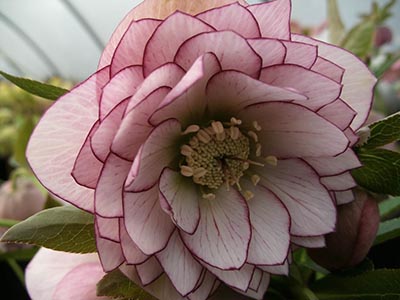
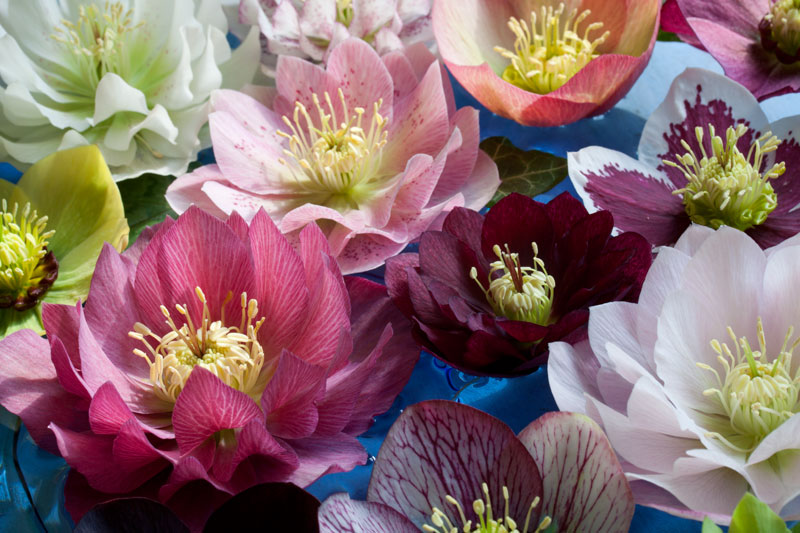
Most of the plants we grow in our gardens under the name orientalis are of mixed blood. In other words they are hybrids not purely derived from the species orientalis but have been crossed with related species. It has been decided that a more accurate classification is H.hybridus, but they are still often referred to as orientalis hybrids.
It is not difficult to see that these plants have undergone an amazing transformation in recent years. A small group of enthusiasts have been working quietly for many years to achieve these improvements - it can take several generations of plants (or more) to result in a dramatic move forward, but the patience of hybridists is now being repaid with exceptional results. This has lead to an increase of interest from gardeners and strong demand for the best quality plants. Today we have flowers that range in colour from white and yellow to red, purple and blue-black. Some have spots or dark blotches, while others have veining on their petals picked out in contrasting colours. Doubles, and anemone centred plants where the nectaries have enlarged to look like a ring of small petals in the flower centre, are proving very popular. The wide range of colours and forms in existence today does not mean that this is the end of the story. For instance, most yellows available are a pale primrose shade, so plants with brighter colouring are being selected. Their offspring are then selected not just for colour but for health and vigour, so standards continually improve. Depending on the goals that each breeder sets we can look forward to many new developments such as taller or shorter plants, bigger or brighter flowers with rounder or more pointed petals, endless multicolour combinations or attractive refined foliage. The possibilities are never ending.

At first glance this flower appears nothing unusual. But take a closer look and you will notice that each inner petal is divided at its tip creating an interesting effect worth developing.
One of my own aims has always been for a flower with a slate-blue outside and a primrose inside, but many years down the line I have learnt that it is infinitely easier to imagine such things than to achieve them. Ultimately only perseverance and a lot of luck will determine if I reach this goal. Many of the developments I work on are slightly less ambitious and when I am rewarded with an exceptional new plant half of me marvels at how beautiful it is, while the other half ponders as to how it could be made even better. It is a constant battle between satisfaction and dissatisfaction and so it will (and should, I think!) remain, as I have always been a perfectionist.

A striking plant with red filaments
December 2012. My plan is to gradually build up a record of the various lines I am working on, along with information on some of my best new plants. Eventually this should show how things have progressed over time - and how they are likely to progress in the future, by detailing some of my goals and how close I am to achieving them.
When I first started growing hellebores, if you wanted a red-coloured one then the choice was either a fairly deep burgundy, or a lighter, slightly muddy dark pink. Over time the latter has become an increasingly clear and bright tone - lovely if you want a really colourful flower. Many people class this colour as red, but to my way of thinking it is more a deep pink, so I have always referred to it as pink-red.
For a number of years I have been working on a true red, and the picture below shows the current difference between the two colours (the 3 blooms on the left are the new colour).

Although at first the idea of a true red hellebore seemed highly unlikely, if not impossible, I can now see that I have a reasonable chance of success, but there is still a considerable way to go before the colour is perfected.
In addition, I am developing an unusually dark red form, with some examples being almost black-red. The best plants display a very distinctive feature: a high gloss finish to the outer side of the petals that enhances the colour considerably.


I have always been a big fan of small-flowered species hellebores, but have never grown very many in the past for the simple reason that they are not the easiest to grow successfully without special care. I am referring to types such as multifidus, a charming little plant that has no problem with the cold here in the UK, but often resents the accompanying wet. As a result it often fails to thrive for me, and black spot is frequently a problem.
There's a big difference between a plant that produces just a few rather small and insignificant flowers unless given special treatment, and one that - although still small-flowered - is vigorous and clumps well. So my aim has been to produce a range of small, dainty plants that have the vigour of H.hybridus. I can think of nothing better, for the natural garden, than a robust little hellebore covered in hundreds of one and a half inch flowers; the perfect partner for snowdrops.


After years of no success (the plants were either weak or the flowers were too large) I was surprised, a couple of years back, to find that some of the plants from this breeding line were growing on really well, and quickly spreading to form decent clumps. They are charming little things, and improving all the time, but sadly are often overlooked when seen beside their showier cousins. Perhaps this is simply because they are limited, at present, to 'quiet' colours such as green and purple.
While on the subject of small flowers I would like to mention a new plant selected in 2011 - one that shows great promise and could be the start of a whole new line. For many years, fans of double-flowered hellebores have had a fine selection of torquatus doubles to choose from if they want a smallish-flowered plant. This might now be taken a stage further as the plant below displays tiny flowers no more than an inch and a half across. It's all in proportion, and shows signs of being quite vigorous.

There have been great improvements to all the doubles over the past decade. One of the problems I originally found was that the outer petals tended to be green or discoloured to some degree, and this spoilt the overall effect. This has now been improved considerably, although there's still a way to go on some lines. The flower shape is getting better all the time, and a good percentage have at least some of their flowers facing outwards which always proves popular. The topic of outward and upward-facing flowers is a bit of a sticky one. First we need to consider that the two things are not one and the same. Visitors invariably ask me for hellebores with upward-facing flowers, but my experience of such plants is that the cupped blooms tend to collect water, causing the stamens to form a black, mouldy lump in the centre of the flower - not the effect that most people might imagine or want! What they desire, of course, is a flower that's easy to see, but the whole appearance of the plant is changed, and not necessarily in a beneficial way, as a rather 'stiff' look is often the result. Consequently, this is not something I am working towards. But I do see the advantage of outward-facing blooms (as in the photos below), and I'm developing many of my lines with this in mind - double and anemone flowers, or those with pretty markings to the interior, probably stand most to gain. Currently, only the odd plant appears with all its flowers facing outwards, but many now have at least a percentage (often the first flower to open on an individual stem, while subsequent ones are pendulous). I am not trying to eliminate pendulous flowers from all my hellebores though - far from it - as I think they create an elegant appearance, and one that is worth retaining.



Anemone hellebores are a great interest of mine - they hold incredible possibilities and, I am sure, have a very exciting future. Depending on individual breeder's aims, they have the potential to develop in many different ways, but it is safe to assume that most of us are looking for large and attractively ruffled centres.
The biggest problem is that, as a line, they tend to be very variable. The first anemone centres were produced by crossing single hellebores with doubles, and in my experience, I found this produced mainly singles along with the odd anemone. This varied, percentage wise, from 6 or 7 out of 20 with my very best plant, which I feel was highly unusual, to something like 1 to 3 - or even none - which was quite common. Frequently, the enlarged nectarines that form the central ruff failed to enlarge enough to produce an attractive flower, and another difficulty was that the singles were often of a poor quality, and many found their way straight to the compost heap! For the second generation, the percentage of anemones improved slightly, but this varied from plant to plant, with some simply refusing to produce many, or any, good examples.
I have now reached the fourth generation and there's still a way to go before each plant from a batch displays a good centre, but some are trying their very best, and who could fail to be swayed and encouraged by such fascinating and potentially beautiful things. All is forgiven when an amazing new example opens for the first time - a fitting reward for many years of hard work.

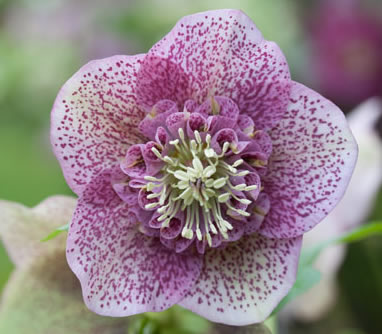
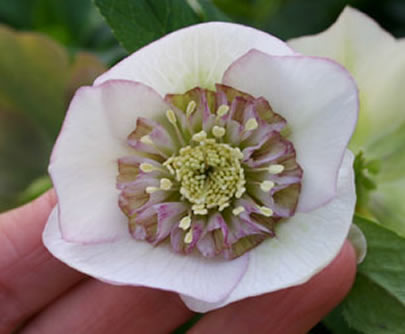
When the first anemones appeared, there was some debate as to whether they should be classed as semi-doubles. Most people now call them anemone centres, and I feel this is right.
If you look closely at the enlarged nectaries, you will see that most retain their original tubular form, or at least partly retain it, but when a double example turns up in a batch of anemones the nectaries will have developed further to become a petal shape. So what happens when a plant is half-way between the two? The example below demonstrates this well.

For a few years I pondered as to whether this type should be classed as semi-double to save confusion. The centres are larger and nearly always consist of small, flat petals. In contrast, anemones have tube type centres, although there are some exceptions. To further complicate things, I have a line that produces spoon-shaped petals that are not very numerous, so definitely not the average anemone ruff, and they are quite long. To help distinguish between the different forms, I have decided to use both terms.
2014. Generally, I'm pleased with the new hellebores selected and grown-on this year. Most have proved vigorous, increasing well in size over the summer and autumn. Putting plant vigour high on my list of priorities seems to be paying off, with obvious improvement over the last few years. It always intrigues me how the smallest detail – whether good or bad – can potentially follow through the generations, so nothing must be missed when selecting a plant for hybridising. For instance, the positioning of petals within a double flower can vary considerably from a full ball shape to something almost flat with the petals laying on top of each other. Some choices are purely personal, while others (such as vigour) are essential to the development of good plants.
The black-flowered singles are showing signs of progress. Most black flowers are, on close inspection, not true black, but consist of a certain degree of colour - often a very dark purple. I've grown blue-black hellebores for quite some time now, and these are usually sold (including by myself) as black, although – strictly speaking - they are paler in colour. This is partly the result of a 'bloom' that covers the petals. In certain lights they do appear black, but I am trying to develop hellebores with a proper black colouring. For every person who understands why I might want to do this, there must be ten more that can't see the point. I have to agree that the idea of a black flower can seem strange, and I also acknowledge that the positioning of such plants can be tricky. Nevertheless, a while back I realised that if the pale coating could be bred out, the result would be something nearer to jet black. A very dark red-black hellebore in my collection does not display this bloom, so the two lines were crossed and the flowers of the resulting plants have dark glossy petals. Side by side, the two 'black' colours (black and blue-black) look obviously different, and while the new plants are not necessarily better than the old ones, they are hopefully a step closer to a line of true black hellebores.


It is worth mentioning the new foliage (bracts) that surrounds the flowers on some plants. Most plants display the usual green colouring, while on a limited number it's much darker, and this trait appears to be connected to cold temperatures. The darker bracts are usually seen on dark-flowered hellebores, but occasionally a plant appears with flowers that are lighter than the foliage, such as the pink-red hellebore shown below, creating an unusual effect. When the main leaves emerge a little later on, they are always green, but while plants are in flower the overall appearance of the two types – dark versus green foliage, while displaying identical blooms – can be surprisingly different.



Picotee doubles are the real show-stoppers of the hellebore world. Love them or hate them (and plenty of people find them too highly bred in appearance), they cannot be ignored. Going back to my early days of collecting, I'm not even sure that there were any picotee doubles. I certainly didn't have any, apart from the odd H.torquatus plant with a slight lick of pink or purple around the edges of its petals. Most of the plants in my collection have been bred from my own picotee anemones, and the original cross was a white spotted double and a picotee single. The latter had veining on its petals, so my first anemones, and subsequent doubles, mainly had veining - this seems to be quite a dominant feature. Although most are a combination of white/cream base with pink or purple markings, as the years have passed it's surprising how varied the plants have become. One line I am working on has intricately veined petals.
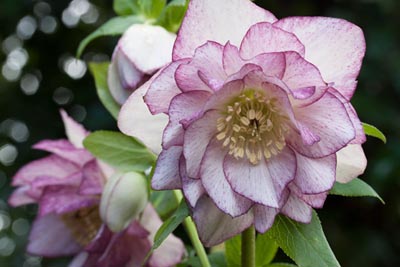









It can be difficult to know in which direction to work when the possibilities for new colour combinations are endless. The danger can be in letting quantity rule over quality, so I have avoided the temptation to work on too many lines. The picotee doubles must surely be an opportunity for enthusiasts to come up with something different, so how about yellow or pink with a really dark edge?
There has been an increasing tendency over recent years to breed a wide variety of different plants with an unnatural appearance. Often the flower heads appear way too big, sitting atop short and sturdy stems. The colour is usually as bright as possible while the flower form can be more than a little strange: I've seen odd and contorted examples that almost look like the result of a virus. The constant pursuit of novelty can be a mixed blessing, and in this regard Rudbeckia Green Wizard must surely have the perfect selling point - OK, flower arrangers love it, but what is the point of a flower with no petals! It still makes me smile when I recall a batch of these plants, at a charity plant sale, being snapped up by a group of extremely enthusiastic ladies. I couldn't understand it then, and I still don't now. There's no doubt that these creations have their place, amply demonstrated by their popularity, but I feel a sense of unease at the way things are potentially going with many of our popular plants, and that includes hellebores. One of the greatest appeals of hellebores is their ability to sit comfortably in the garden - they blend beautifully with the more modest winter/spring offerings and have an elegance that could easily be lost. At the same time I can see how the term 'natural' can easily be applied to plants that are simply of poor shape and colour. It's a tricky balance, but the prospect of the very thing that is so charming about hellebores being lost is quite real. The picotee doubles are some of my most showy plants, and I understand they are not to everyone's taste, so hopefully I have not quite overstepped the mark in this respect!
April 2016. Some hellebores age better than others, and by that I mean that their flowers look good over a prolonged period of time, perhaps up to 4 months. The dark varieties are a perfect example, as they don't tend to fade, and they retain their colour until the old heads are removed, usually in May. With flowers that last for so long, it is an important point to consider when selecting hellebores for breeding work. Whites and yellows age well, fading to green in a 'clean' way, but I've often observed that pinks can be more of a problem - pink fading to green can easily become an unattractive colour. There are always exceptions to the rule though, and the photo below shows the mature blooms of a plain pink double, looking very attractive with picotee markings that only emerge as the flowers age.

It is also interesting to note the extended period of interest that is provided by plants with finely divided foliage. I have never found the standard hybridus leaves particularly attractive, although other people say they do, but plants that display a mop of filigree foliage have something special to offer for most of the year. The most finely divided leaves are displayed on plants with H.multifidus blood, and I have been using this species in my breeding work for many years. The resulting plants are not particularly commercial, so consequently I only produce small numbers and unfortunately this has slowed development. It can be quite tricky getting plants that have everything going for them: good foliage, good quantity and quality of flower, and good disease resistance.

Helleborus multifidus subsp. multifidus
June 2020. I have continued with the development of my miniature hybrids, and there has been some good progress over the last 5 years. The plants are now showing increased vigour – something that was lacking in earlier selections. When compared to a standard double, the plants are tiny, both in height and flower size. Stems are about 6 inches tall, although some are higher, and flowers are generally between 1 and 1.5 inches wide. They make fine companions for small and delicate winter plants such as hepaticas and snowdrops.
Colours are currently restricted to yellow and peach shades, with other colours in development.
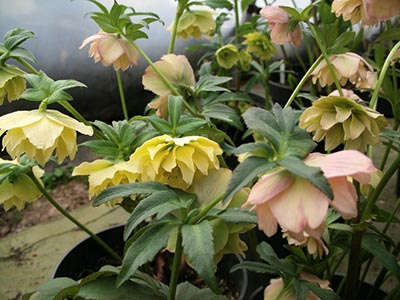

The doubles can differ widely in their appearance, and this is not just due to colour and shape. The number of petals on a flower is equally important, with some having just two or three layers. As the petal-count rises, the flowers become increasingly full and frilly, and this can create an attractive effect. A number of years ago, I was lucky enough to receive a beautiful plant, and some seed, from a Japanese grower. This has formed the basis of a new line of full doubles. The first generation, while having beautiful flowers, were rather spindly in growth, and the heavy heads hung downwards. This prevented the flowers from being seen and properly appreciated, so I am using my own stock of doubles with outward-facing flowers to hopefully produce an improved strain. I am now working on the third generation, and there is still a way to go!

